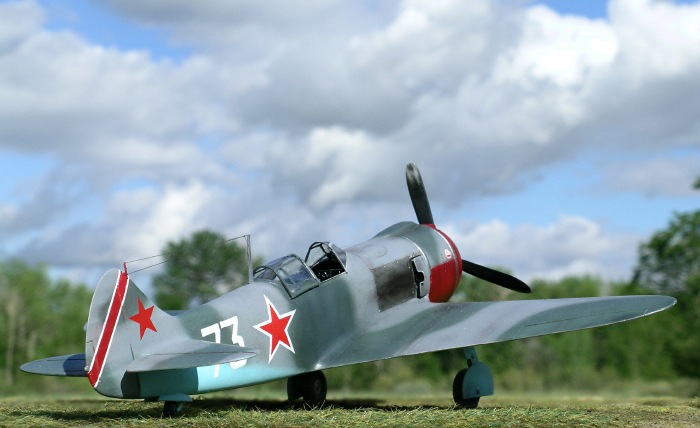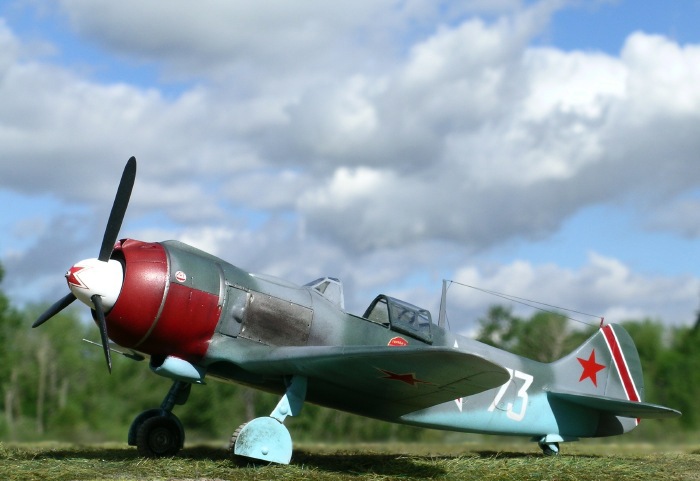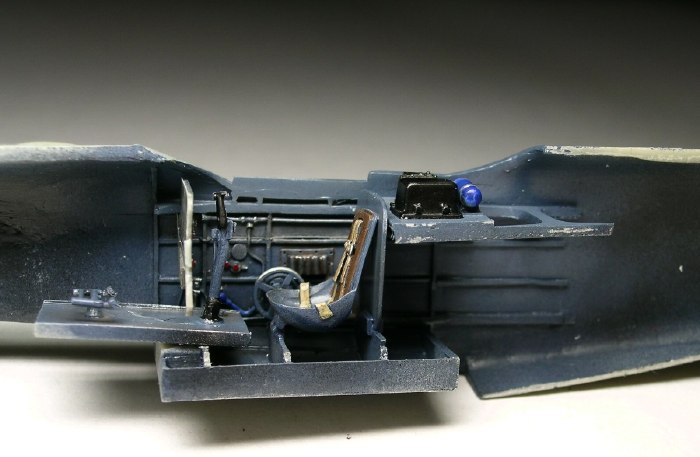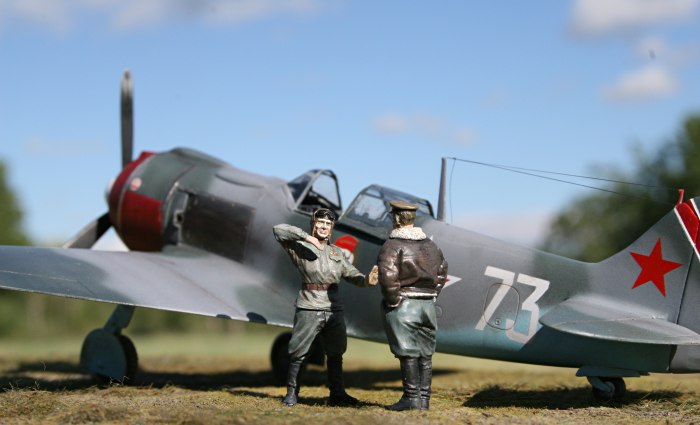|
Vector’s 1/48 scale resin
Lavochkin La-5F
by
Ian Robertson
|
 |
|
Lavochkin La-5F |

HyperScale is proudly supported by Squadron.com
Russia’s Lavochkin La-5F was essentially an La-5
with a more powerful engine (the F stands for Forsirovanny =
boosted) and an improved canopy with a cut down rear fuselage decking
that provided the pilot better visibility to the rear. Introduced in
March 1943, only a few months before the La-5FN, the first La-5Fs
retained the green and black camouflage found on La-5s. However, most
La-5Fs off the assembly line wore the familiar dark grey (AMT-12) and
medium grey (AMT-11) camouflage seen on later Russian fighters. The
La-5F performed well but was upstaged by the superior La-5FN and later
the La-7.
Here I present “White 73”, an La-5F piloted by Petr
Maminov, 193 IAP, spring 1944. The scheme I selected was based on a
profile by Chris Banyai-Riepl in the August 2003 issue of Internet
Modeler. I couldn’t find any reference photographs of the actual
aircraft.
Vector’s La-5F
The La-5F is the second complete aircraft kit from
Vector, arriving on the heels of their beautiful La-5. An in-box review
of the La-5F kit can be found at
http://kits.kitreview.com/vector48002reviewbg_1.htm. Vector
products are distributed in North America by Buffie’s Best (http://www.buffiesbest.com/)
and in the UK by Neomega Resin (http://www.neomega-resin.com/).
The La-5F kit more-or-less identical to the La-5
kit, apart from the modified fuselage halves and new canopy. As with
the La-5 kit, rubber wheels (by Avia Equipage) are supplied, but they do
not match the quality of the rest of the kit. I replaced the kit’s main
wheels with True Details resin La-5 wheels, available at Squadron.

Only one vacuform canopy is included in the kit,
and it is designed in such a way that all three sections must be
attached separately to the model. For me this created a problem
because I found that the center section was a touch too small to fit
comfortably over the rear canopy when positioned open, and I did not
like the look when I tried to position the three pieces as a closed
canopy (there were small gaps between the frames that would have been
tricky to correct, and with only one canopy at my disposal I didn’t want
to take the risk). I would have preferred it if Vector had supplied two
canopies, one designed for displaying the canopy open (with the center
piece just a touch larger so it would fit comfortably over the rear
section), and the other as a single piece for displaying the canopy
closed. I prefer the closed look on the La-5F because it preserves the
aircraft’s unusual lines. Note: For those thinking of using
Squadron’s La-5 vacuform canopy (designed for the Hobbycraft kit), it is
too narrow for the Vector kit. Gavia’s La-7 injection molded canopy is
narrower still.
As with the Vector La-5, construction was straight
forward and simple. The fit is excellent and rivals or exceeds many
injection molded kits. Nevertheless, it is essential to dry fit because
CA glue is unforgiving when it comes to repositioning parts.
The cockpit is well detailed yet spartan, as one
would expect in a Russian fighter of this era. I painted the cockpit
bluish grey in an effort to approximate “Wood Aerolak” as indicated in
Pilawskii’s “Soviet Air Force Fighter Colours 1941-1945” (pp 14, 64).

The Vector kit does not include a pitot tube or
antenna mast. I made a pitot tube by inserting a piece of syringe
tubing into a small plastic fairing that I then attached to the
underside of the starboard wing. A suitable antenna mast was found in
my spares box. The antenna wires were made from stretched sprue.
Prior to painting I primed the model with Tamiya
fine grey primer from a rattle can. Once the primer was dry I buffed
the surfaces lightly with a micromesh sanding cloth. The red on the
cowl was then sprayed and masked until the rest of painting was
complete.
The scheme I chose for my model is not available in
decals. To make the numbers on the fuselage I painted the rear fuselage
white and then cut and applied masks made from Tamiya tape. The star on
the spinner was a decal from Accurate Miniatures’ Yak-1b kit, whereas
the remainder of the markings, including the badge beneath the cockpit,
were scavenged from various Aeromaster decal sheets.
 The
camouflage scheme was standard AMT-11/12 (medium grey/dark grey) over
AMT-7 (blue). I used the White Ensign Models’ Russian aircraft colors
as references for mixing my own colors using Polly Scale Acrylic (I
prefer acrylics over enamels). For AMT-11 I mixed British Medium Sea
Grey with RLM75 (grey violet), and for AMT-12 I mixed German Uniform
Grey (grey-green) with a touch of RLM66 (dark grey). For AMT-7 I used
USSR underside blue mixed with white. I was pleased with the close
match to White Ensign’s paints; I particularly like the greenish tinge
to the AMT-12 compared to the more frequently seen dark grey on models. The
camouflage scheme was standard AMT-11/12 (medium grey/dark grey) over
AMT-7 (blue). I used the White Ensign Models’ Russian aircraft colors
as references for mixing my own colors using Polly Scale Acrylic (I
prefer acrylics over enamels). For AMT-11 I mixed British Medium Sea
Grey with RLM75 (grey violet), and for AMT-12 I mixed German Uniform
Grey (grey-green) with a touch of RLM66 (dark grey). For AMT-7 I used
USSR underside blue mixed with white. I was pleased with the close
match to White Ensign’s paints; I particularly like the greenish tinge
to the AMT-12 compared to the more frequently seen dark grey on models.
The panel behind each exhaust was painted with
Alclad II duraluminum. The exhaust stains were made by spraying highly
thinned black paint.
The two figures in some of the images are from
Aires’ “Russian Aces” set (item 4002).

As with Vector’s La-5 kit, I really enjoyed
building the Vector La-5F. While construction was straightforward, I
would not recommend this kit to modelers lacking experience with resin
or vacuform canopies. The kit is expensive, so mistakes resulting from
inexperience would be tough to swallow. However, if you have a few
resin cockpits under your belt you should have no difficulty with this
kit. I would like to build another Vector La-5F, but I will need to
figure out a more satisfying solution for the canopy so I can display it
closed. Perhaps I should just get better working with vacuform
canopies.
Click on the thumbnails
below to view larger images:
Model, Images and Text Copyright ©
2006 by Ian Robertson
Page Created 05 June, 2006
Last Updated 04 June, 2006
Back to HyperScale
Main Page
|
Home
| What's New |
Features |
Gallery |
Reviews |
Reference |
Forum |
Search